Financial Analysis of DuoLever Business Case Study (ACC00716)
VerifiedAdded on 2022/12/30
|13
|1612
|44
Case Study
AI Summary
This case study presents a financial analysis of DuoLever Limited, a company in the personal care industry, facing a decision on how to implement its newly developed soft plastic recycling method. The analysis compares two options: adding recycled sachet plastic production (Option 1) or licensing the recycling method to Clean World Ltd (Option 2). The study utilizes capital budgeting techniques, including Net Present Value (NPV), Internal Rate of Return (IRR), and payback period, to evaluate the financial viability of each option. The analysis reveals that Option 2, licensing the method, has a higher NPV and a shorter payback period, making it the recommended choice. The case also considers potential uncertainties like fluctuations in sales benefits and maintenance costs, using scenario analysis to assess their impact. Ultimately, while Option 2 is favored based on financial metrics, the study emphasizes the need for additional due diligence regarding licensing terms and potential operational impacts to make a final decision.
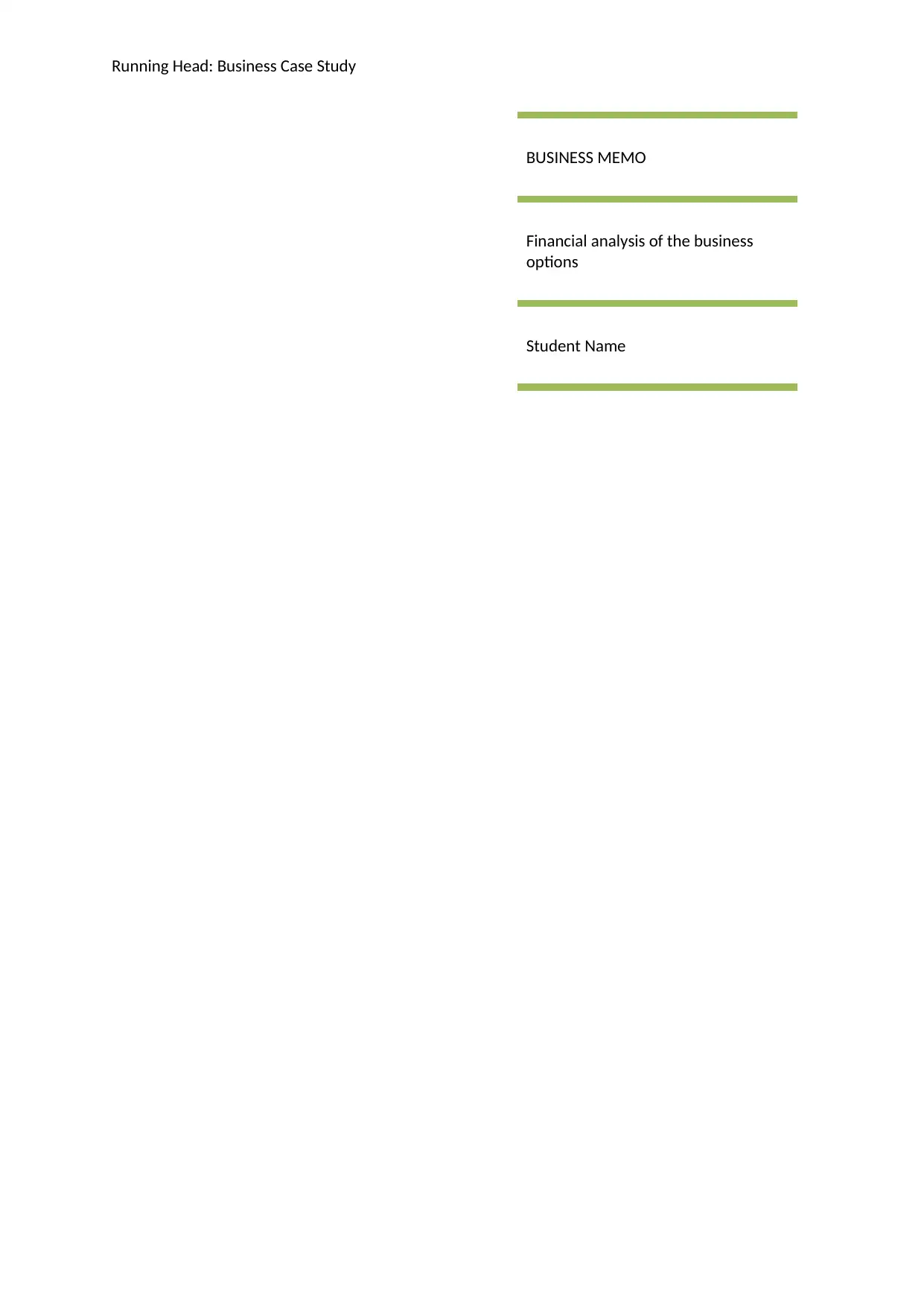
Running Head: Business Case Study
BUSINESS MEMO
Financial analysis of the business
options
Student Name
BUSINESS MEMO
Financial analysis of the business
options
Student Name
Paraphrase This Document
Need a fresh take? Get an instant paraphrase of this document with our AI Paraphraser
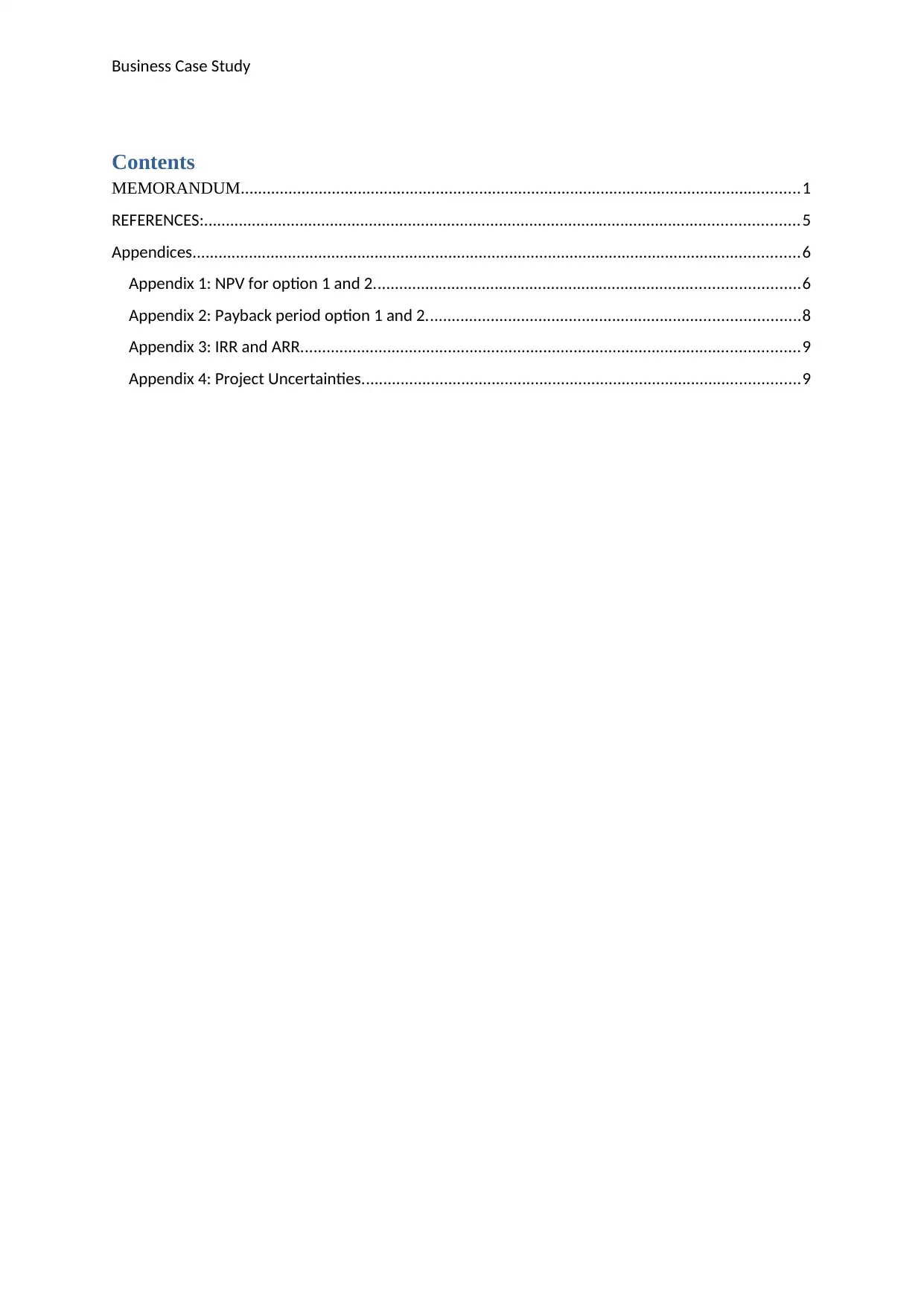
Business Case Study
Contents
MEMORANDUM.................................................................................................................................1
REFERENCES:.........................................................................................................................................5
Appendices............................................................................................................................................6
Appendix 1: NPV for option 1 and 2..................................................................................................6
Appendix 2: Payback period option 1 and 2......................................................................................8
Appendix 3: IRR and ARR...................................................................................................................9
Appendix 4: Project Uncertainties.....................................................................................................9
Contents
MEMORANDUM.................................................................................................................................1
REFERENCES:.........................................................................................................................................5
Appendices............................................................................................................................................6
Appendix 1: NPV for option 1 and 2..................................................................................................6
Appendix 2: Payback period option 1 and 2......................................................................................8
Appendix 3: IRR and ARR...................................................................................................................9
Appendix 4: Project Uncertainties.....................................................................................................9

Business Case Study
⊘ This is a preview!⊘
Do you want full access?
Subscribe today to unlock all pages.

Trusted by 1+ million students worldwide
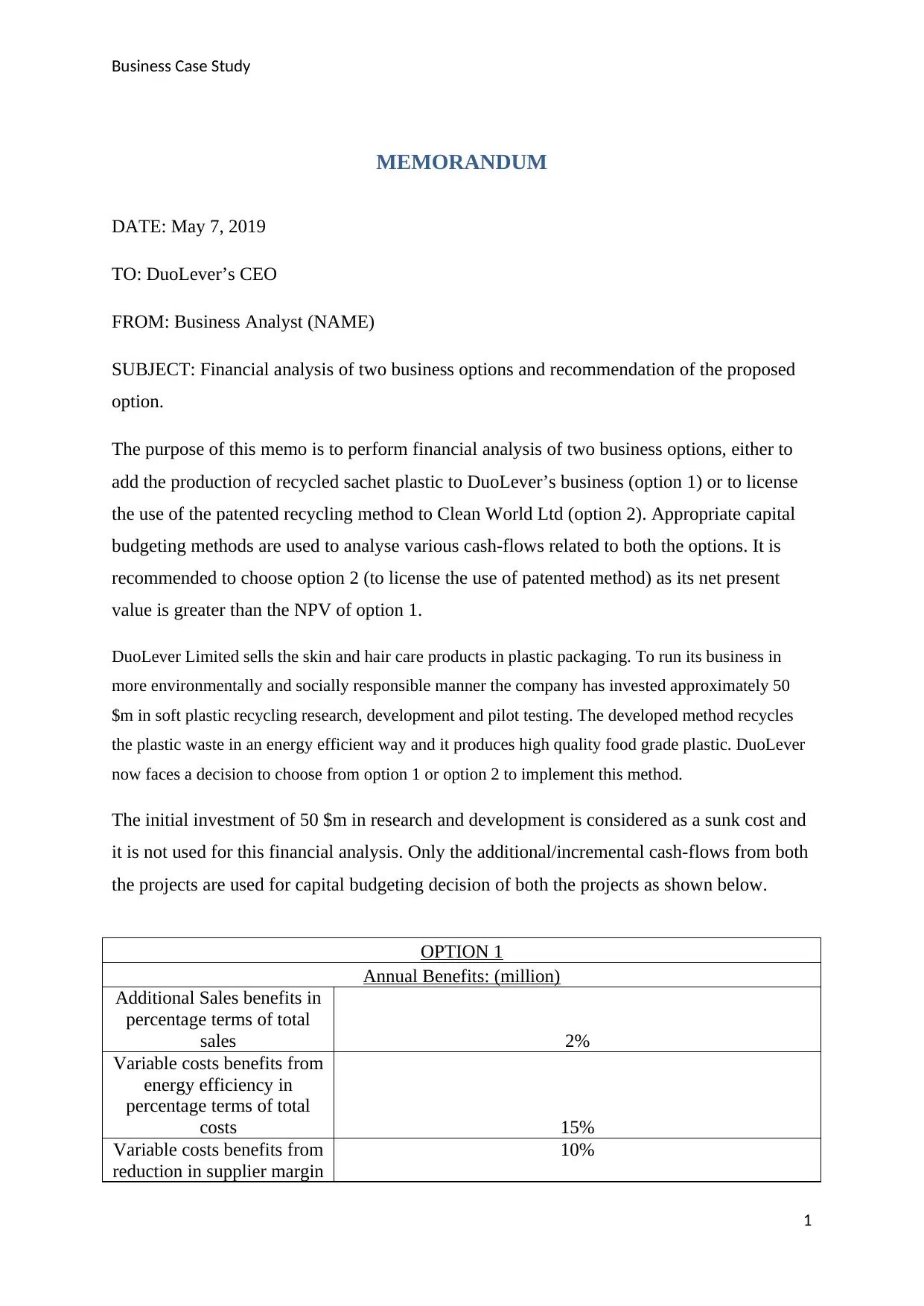
Business Case Study
MEMORANDUM
DATE: May 7, 2019
TO: DuoLever’s CEO
FROM: Business Analyst (NAME)
SUBJECT: Financial analysis of two business options and recommendation of the proposed
option.
The purpose of this memo is to perform financial analysis of two business options, either to
add the production of recycled sachet plastic to DuoLever’s business (option 1) or to license
the use of the patented recycling method to Clean World Ltd (option 2). Appropriate capital
budgeting methods are used to analyse various cash-flows related to both the options. It is
recommended to choose option 2 (to license the use of patented method) as its net present
value is greater than the NPV of option 1.
DuoLever Limited sells the skin and hair care products in plastic packaging. To run its business in
more environmentally and socially responsible manner the company has invested approximately 50
$m in soft plastic recycling research, development and pilot testing. The developed method recycles
the plastic waste in an energy efficient way and it produces high quality food grade plastic. DuoLever
now faces a decision to choose from option 1 or option 2 to implement this method.
The initial investment of 50 $m in research and development is considered as a sunk cost and
it is not used for this financial analysis. Only the additional/incremental cash-flows from both
the projects are used for capital budgeting decision of both the projects as shown below.
OPTION 1
Annual Benefits: (million)
Additional Sales benefits in
percentage terms of total
sales 2%
Variable costs benefits from
energy efficiency in
percentage terms of total
costs 15%
Variable costs benefits from
reduction in supplier margin
10%
1
MEMORANDUM
DATE: May 7, 2019
TO: DuoLever’s CEO
FROM: Business Analyst (NAME)
SUBJECT: Financial analysis of two business options and recommendation of the proposed
option.
The purpose of this memo is to perform financial analysis of two business options, either to
add the production of recycled sachet plastic to DuoLever’s business (option 1) or to license
the use of the patented recycling method to Clean World Ltd (option 2). Appropriate capital
budgeting methods are used to analyse various cash-flows related to both the options. It is
recommended to choose option 2 (to license the use of patented method) as its net present
value is greater than the NPV of option 1.
DuoLever Limited sells the skin and hair care products in plastic packaging. To run its business in
more environmentally and socially responsible manner the company has invested approximately 50
$m in soft plastic recycling research, development and pilot testing. The developed method recycles
the plastic waste in an energy efficient way and it produces high quality food grade plastic. DuoLever
now faces a decision to choose from option 1 or option 2 to implement this method.
The initial investment of 50 $m in research and development is considered as a sunk cost and
it is not used for this financial analysis. Only the additional/incremental cash-flows from both
the projects are used for capital budgeting decision of both the projects as shown below.
OPTION 1
Annual Benefits: (million)
Additional Sales benefits in
percentage terms of total
sales 2%
Variable costs benefits from
energy efficiency in
percentage terms of total
costs 15%
Variable costs benefits from
reduction in supplier margin
10%
1
Paraphrase This Document
Need a fresh take? Get an instant paraphrase of this document with our AI Paraphraser
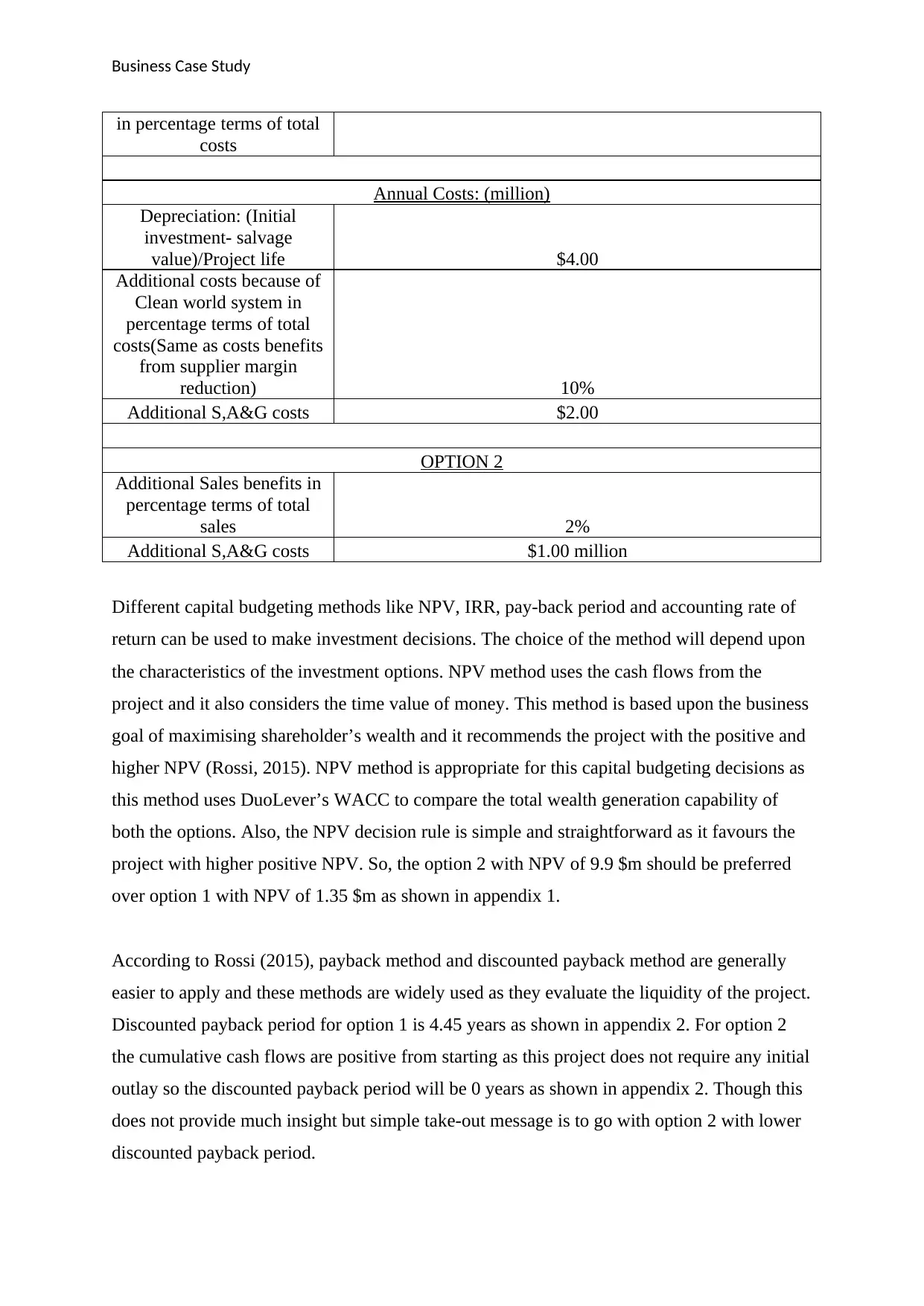
Business Case Study
in percentage terms of total
costs
Annual Costs: (million)
Depreciation: (Initial
investment- salvage
value)/Project life $4.00
Additional costs because of
Clean world system in
percentage terms of total
costs(Same as costs benefits
from supplier margin
reduction) 10%
Additional S,A&G costs $2.00
OPTION 2
Additional Sales benefits in
percentage terms of total
sales 2%
Additional S,A&G costs $1.00 million
Different capital budgeting methods like NPV, IRR, pay-back period and accounting rate of
return can be used to make investment decisions. The choice of the method will depend upon
the characteristics of the investment options. NPV method uses the cash flows from the
project and it also considers the time value of money. This method is based upon the business
goal of maximising shareholder’s wealth and it recommends the project with the positive and
higher NPV (Rossi, 2015). NPV method is appropriate for this capital budgeting decisions as
this method uses DuoLever’s WACC to compare the total wealth generation capability of
both the options. Also, the NPV decision rule is simple and straightforward as it favours the
project with higher positive NPV. So, the option 2 with NPV of 9.9 $m should be preferred
over option 1 with NPV of 1.35 $m as shown in appendix 1.
According to Rossi (2015), payback method and discounted payback method are generally
easier to apply and these methods are widely used as they evaluate the liquidity of the project.
Discounted payback period for option 1 is 4.45 years as shown in appendix 2. For option 2
the cumulative cash flows are positive from starting as this project does not require any initial
outlay so the discounted payback period will be 0 years as shown in appendix 2. Though this
does not provide much insight but simple take-out message is to go with option 2 with lower
discounted payback period.
in percentage terms of total
costs
Annual Costs: (million)
Depreciation: (Initial
investment- salvage
value)/Project life $4.00
Additional costs because of
Clean world system in
percentage terms of total
costs(Same as costs benefits
from supplier margin
reduction) 10%
Additional S,A&G costs $2.00
OPTION 2
Additional Sales benefits in
percentage terms of total
sales 2%
Additional S,A&G costs $1.00 million
Different capital budgeting methods like NPV, IRR, pay-back period and accounting rate of
return can be used to make investment decisions. The choice of the method will depend upon
the characteristics of the investment options. NPV method uses the cash flows from the
project and it also considers the time value of money. This method is based upon the business
goal of maximising shareholder’s wealth and it recommends the project with the positive and
higher NPV (Rossi, 2015). NPV method is appropriate for this capital budgeting decisions as
this method uses DuoLever’s WACC to compare the total wealth generation capability of
both the options. Also, the NPV decision rule is simple and straightforward as it favours the
project with higher positive NPV. So, the option 2 with NPV of 9.9 $m should be preferred
over option 1 with NPV of 1.35 $m as shown in appendix 1.
According to Rossi (2015), payback method and discounted payback method are generally
easier to apply and these methods are widely used as they evaluate the liquidity of the project.
Discounted payback period for option 1 is 4.45 years as shown in appendix 2. For option 2
the cumulative cash flows are positive from starting as this project does not require any initial
outlay so the discounted payback period will be 0 years as shown in appendix 2. Though this
does not provide much insight but simple take-out message is to go with option 2 with lower
discounted payback period.
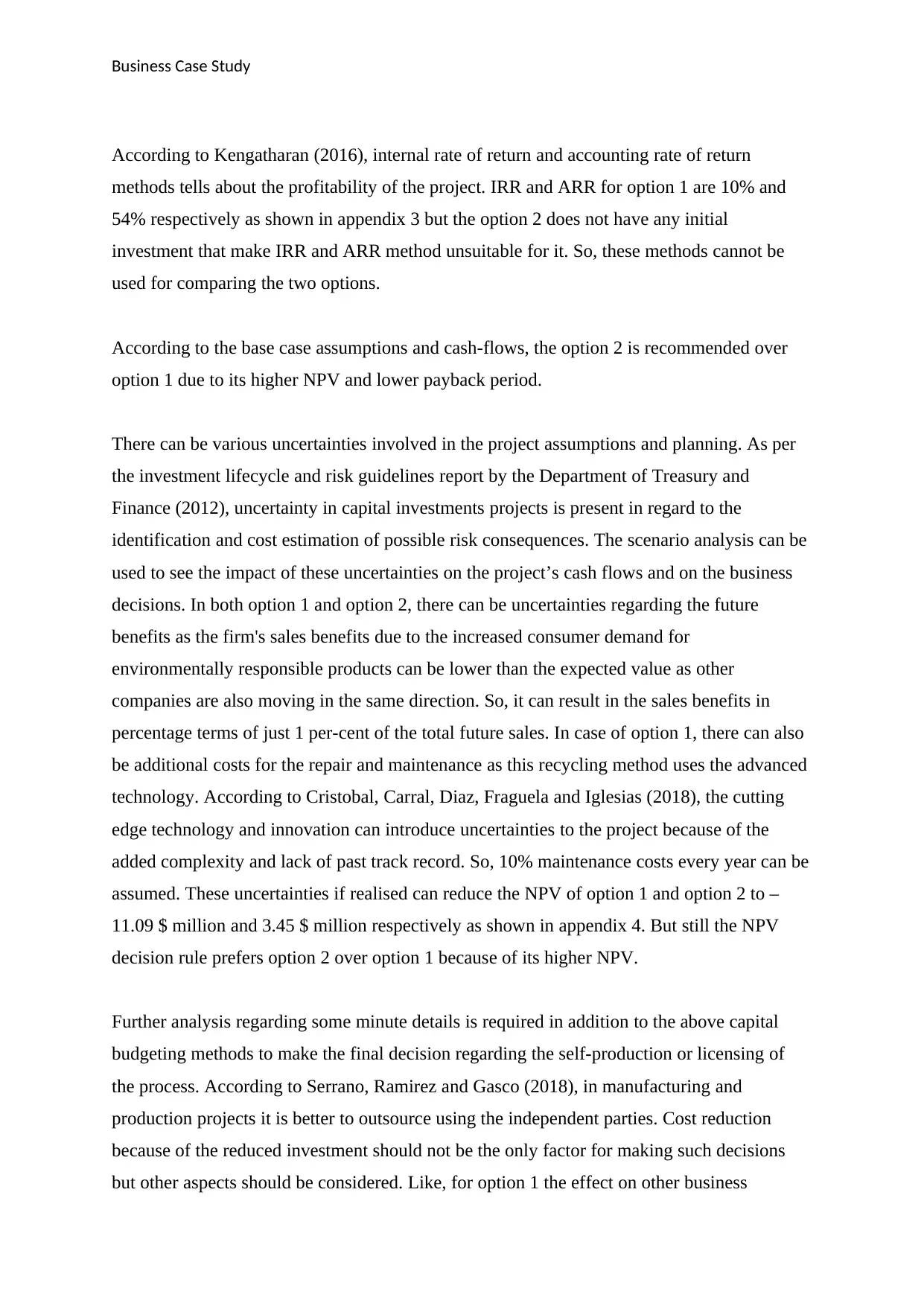
Business Case Study
According to Kengatharan (2016), internal rate of return and accounting rate of return
methods tells about the profitability of the project. IRR and ARR for option 1 are 10% and
54% respectively as shown in appendix 3 but the option 2 does not have any initial
investment that make IRR and ARR method unsuitable for it. So, these methods cannot be
used for comparing the two options.
According to the base case assumptions and cash-flows, the option 2 is recommended over
option 1 due to its higher NPV and lower payback period.
There can be various uncertainties involved in the project assumptions and planning. As per
the investment lifecycle and risk guidelines report by the Department of Treasury and
Finance (2012), uncertainty in capital investments projects is present in regard to the
identification and cost estimation of possible risk consequences. The scenario analysis can be
used to see the impact of these uncertainties on the project’s cash flows and on the business
decisions. In both option 1 and option 2, there can be uncertainties regarding the future
benefits as the firm's sales benefits due to the increased consumer demand for
environmentally responsible products can be lower than the expected value as other
companies are also moving in the same direction. So, it can result in the sales benefits in
percentage terms of just 1 per-cent of the total future sales. In case of option 1, there can also
be additional costs for the repair and maintenance as this recycling method uses the advanced
technology. According to Cristobal, Carral, Diaz, Fraguela and Iglesias (2018), the cutting
edge technology and innovation can introduce uncertainties to the project because of the
added complexity and lack of past track record. So, 10% maintenance costs every year can be
assumed. These uncertainties if realised can reduce the NPV of option 1 and option 2 to –
11.09 $ million and 3.45 $ million respectively as shown in appendix 4. But still the NPV
decision rule prefers option 2 over option 1 because of its higher NPV.
Further analysis regarding some minute details is required in addition to the above capital
budgeting methods to make the final decision regarding the self-production or licensing of
the process. According to Serrano, Ramirez and Gasco (2018), in manufacturing and
production projects it is better to outsource using the independent parties. Cost reduction
because of the reduced investment should not be the only factor for making such decisions
but other aspects should be considered. Like, for option 1 the effect on other business
According to Kengatharan (2016), internal rate of return and accounting rate of return
methods tells about the profitability of the project. IRR and ARR for option 1 are 10% and
54% respectively as shown in appendix 3 but the option 2 does not have any initial
investment that make IRR and ARR method unsuitable for it. So, these methods cannot be
used for comparing the two options.
According to the base case assumptions and cash-flows, the option 2 is recommended over
option 1 due to its higher NPV and lower payback period.
There can be various uncertainties involved in the project assumptions and planning. As per
the investment lifecycle and risk guidelines report by the Department of Treasury and
Finance (2012), uncertainty in capital investments projects is present in regard to the
identification and cost estimation of possible risk consequences. The scenario analysis can be
used to see the impact of these uncertainties on the project’s cash flows and on the business
decisions. In both option 1 and option 2, there can be uncertainties regarding the future
benefits as the firm's sales benefits due to the increased consumer demand for
environmentally responsible products can be lower than the expected value as other
companies are also moving in the same direction. So, it can result in the sales benefits in
percentage terms of just 1 per-cent of the total future sales. In case of option 1, there can also
be additional costs for the repair and maintenance as this recycling method uses the advanced
technology. According to Cristobal, Carral, Diaz, Fraguela and Iglesias (2018), the cutting
edge technology and innovation can introduce uncertainties to the project because of the
added complexity and lack of past track record. So, 10% maintenance costs every year can be
assumed. These uncertainties if realised can reduce the NPV of option 1 and option 2 to –
11.09 $ million and 3.45 $ million respectively as shown in appendix 4. But still the NPV
decision rule prefers option 2 over option 1 because of its higher NPV.
Further analysis regarding some minute details is required in addition to the above capital
budgeting methods to make the final decision regarding the self-production or licensing of
the process. According to Serrano, Ramirez and Gasco (2018), in manufacturing and
production projects it is better to outsource using the independent parties. Cost reduction
because of the reduced investment should not be the only factor for making such decisions
but other aspects should be considered. Like, for option 1 the effect on other business
⊘ This is a preview!⊘
Do you want full access?
Subscribe today to unlock all pages.

Trusted by 1+ million students worldwide
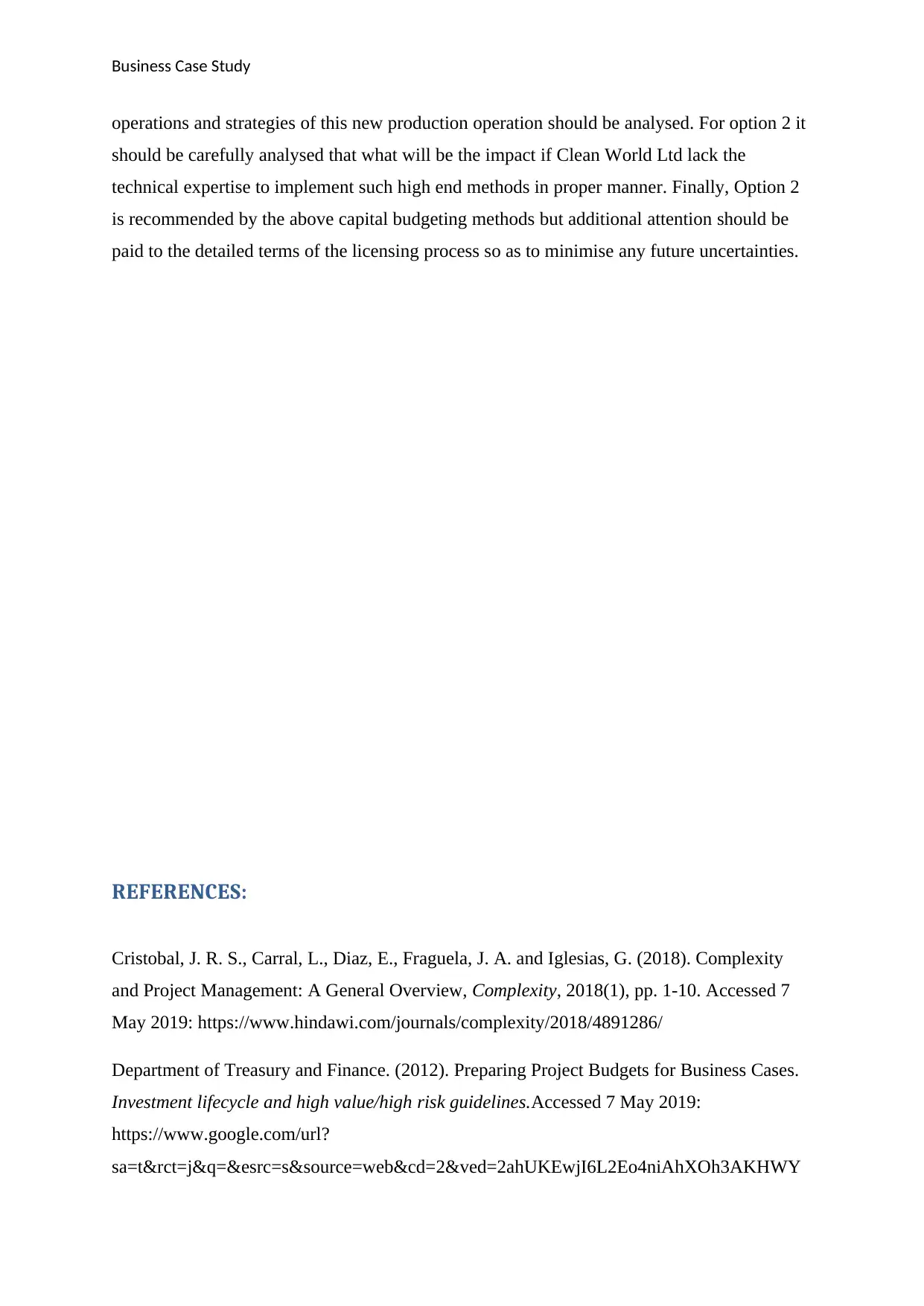
Business Case Study
operations and strategies of this new production operation should be analysed. For option 2 it
should be carefully analysed that what will be the impact if Clean World Ltd lack the
technical expertise to implement such high end methods in proper manner. Finally, Option 2
is recommended by the above capital budgeting methods but additional attention should be
paid to the detailed terms of the licensing process so as to minimise any future uncertainties.
REFERENCES:
Cristobal, J. R. S., Carral, L., Diaz, E., Fraguela, J. A. and Iglesias, G. (2018). Complexity
and Project Management: A General Overview, Complexity, 2018(1), pp. 1-10. Accessed 7
May 2019: https://www.hindawi.com/journals/complexity/2018/4891286/
Department of Treasury and Finance. (2012). Preparing Project Budgets for Business Cases.
Investment lifecycle and high value/high risk guidelines.Accessed 7 May 2019:
https://www.google.com/url?
sa=t&rct=j&q=&esrc=s&source=web&cd=2&ved=2ahUKEwjI6L2Eo4niAhXOh3AKHWY
operations and strategies of this new production operation should be analysed. For option 2 it
should be carefully analysed that what will be the impact if Clean World Ltd lack the
technical expertise to implement such high end methods in proper manner. Finally, Option 2
is recommended by the above capital budgeting methods but additional attention should be
paid to the detailed terms of the licensing process so as to minimise any future uncertainties.
REFERENCES:
Cristobal, J. R. S., Carral, L., Diaz, E., Fraguela, J. A. and Iglesias, G. (2018). Complexity
and Project Management: A General Overview, Complexity, 2018(1), pp. 1-10. Accessed 7
May 2019: https://www.hindawi.com/journals/complexity/2018/4891286/
Department of Treasury and Finance. (2012). Preparing Project Budgets for Business Cases.
Investment lifecycle and high value/high risk guidelines.Accessed 7 May 2019:
https://www.google.com/url?
sa=t&rct=j&q=&esrc=s&source=web&cd=2&ved=2ahUKEwjI6L2Eo4niAhXOh3AKHWY
Paraphrase This Document
Need a fresh take? Get an instant paraphrase of this document with our AI Paraphraser
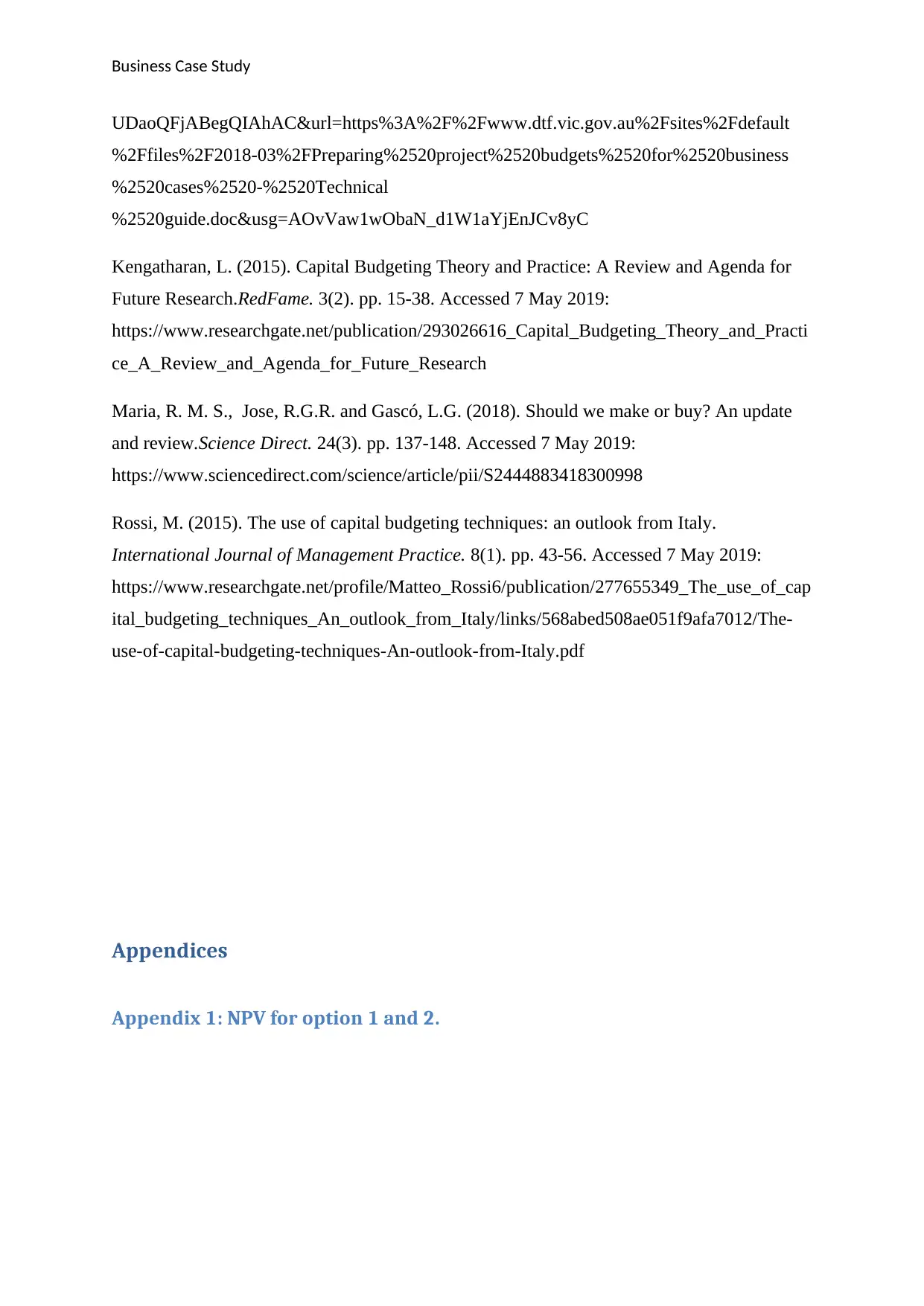
Business Case Study
UDaoQFjABegQIAhAC&url=https%3A%2F%2Fwww.dtf.vic.gov.au%2Fsites%2Fdefault
%2Ffiles%2F2018-03%2FPreparing%2520project%2520budgets%2520for%2520business
%2520cases%2520-%2520Technical
%2520guide.doc&usg=AOvVaw1wObaN_d1W1aYjEnJCv8yC
Kengatharan, L. (2015). Capital Budgeting Theory and Practice: A Review and Agenda for
Future Research.RedFame. 3(2). pp. 15-38. Accessed 7 May 2019:
https://www.researchgate.net/publication/293026616_Capital_Budgeting_Theory_and_Practi
ce_A_Review_and_Agenda_for_Future_Research
Maria, R. M. S., Jose, R.G.R. and Gascó, L.G. (2018). Should we make or buy? An update
and review.Science Direct. 24(3). pp. 137-148. Accessed 7 May 2019:
https://www.sciencedirect.com/science/article/pii/S2444883418300998
Rossi, M. (2015). The use of capital budgeting techniques: an outlook from Italy.
International Journal of Management Practice. 8(1). pp. 43-56. Accessed 7 May 2019:
https://www.researchgate.net/profile/Matteo_Rossi6/publication/277655349_The_use_of_cap
ital_budgeting_techniques_An_outlook_from_Italy/links/568abed508ae051f9afa7012/The-
use-of-capital-budgeting-techniques-An-outlook-from-Italy.pdf
Appendices
Appendix 1: NPV for option 1 and 2.
UDaoQFjABegQIAhAC&url=https%3A%2F%2Fwww.dtf.vic.gov.au%2Fsites%2Fdefault
%2Ffiles%2F2018-03%2FPreparing%2520project%2520budgets%2520for%2520business
%2520cases%2520-%2520Technical
%2520guide.doc&usg=AOvVaw1wObaN_d1W1aYjEnJCv8yC
Kengatharan, L. (2015). Capital Budgeting Theory and Practice: A Review and Agenda for
Future Research.RedFame. 3(2). pp. 15-38. Accessed 7 May 2019:
https://www.researchgate.net/publication/293026616_Capital_Budgeting_Theory_and_Practi
ce_A_Review_and_Agenda_for_Future_Research
Maria, R. M. S., Jose, R.G.R. and Gascó, L.G. (2018). Should we make or buy? An update
and review.Science Direct. 24(3). pp. 137-148. Accessed 7 May 2019:
https://www.sciencedirect.com/science/article/pii/S2444883418300998
Rossi, M. (2015). The use of capital budgeting techniques: an outlook from Italy.
International Journal of Management Practice. 8(1). pp. 43-56. Accessed 7 May 2019:
https://www.researchgate.net/profile/Matteo_Rossi6/publication/277655349_The_use_of_cap
ital_budgeting_techniques_An_outlook_from_Italy/links/568abed508ae051f9afa7012/The-
use-of-capital-budgeting-techniques-An-outlook-from-Italy.pdf
Appendices
Appendix 1: NPV for option 1 and 2.
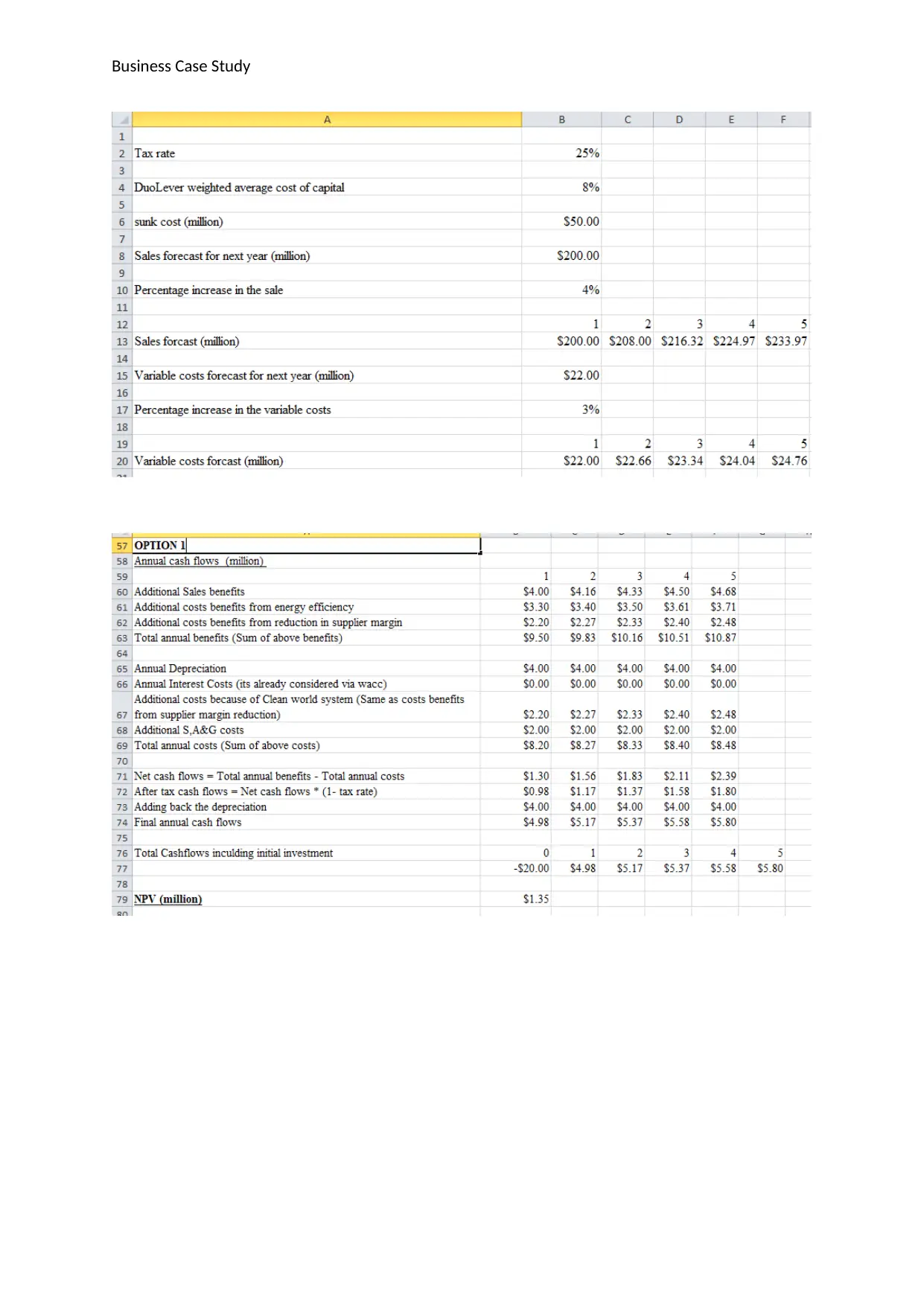
Business Case Study
⊘ This is a preview!⊘
Do you want full access?
Subscribe today to unlock all pages.

Trusted by 1+ million students worldwide
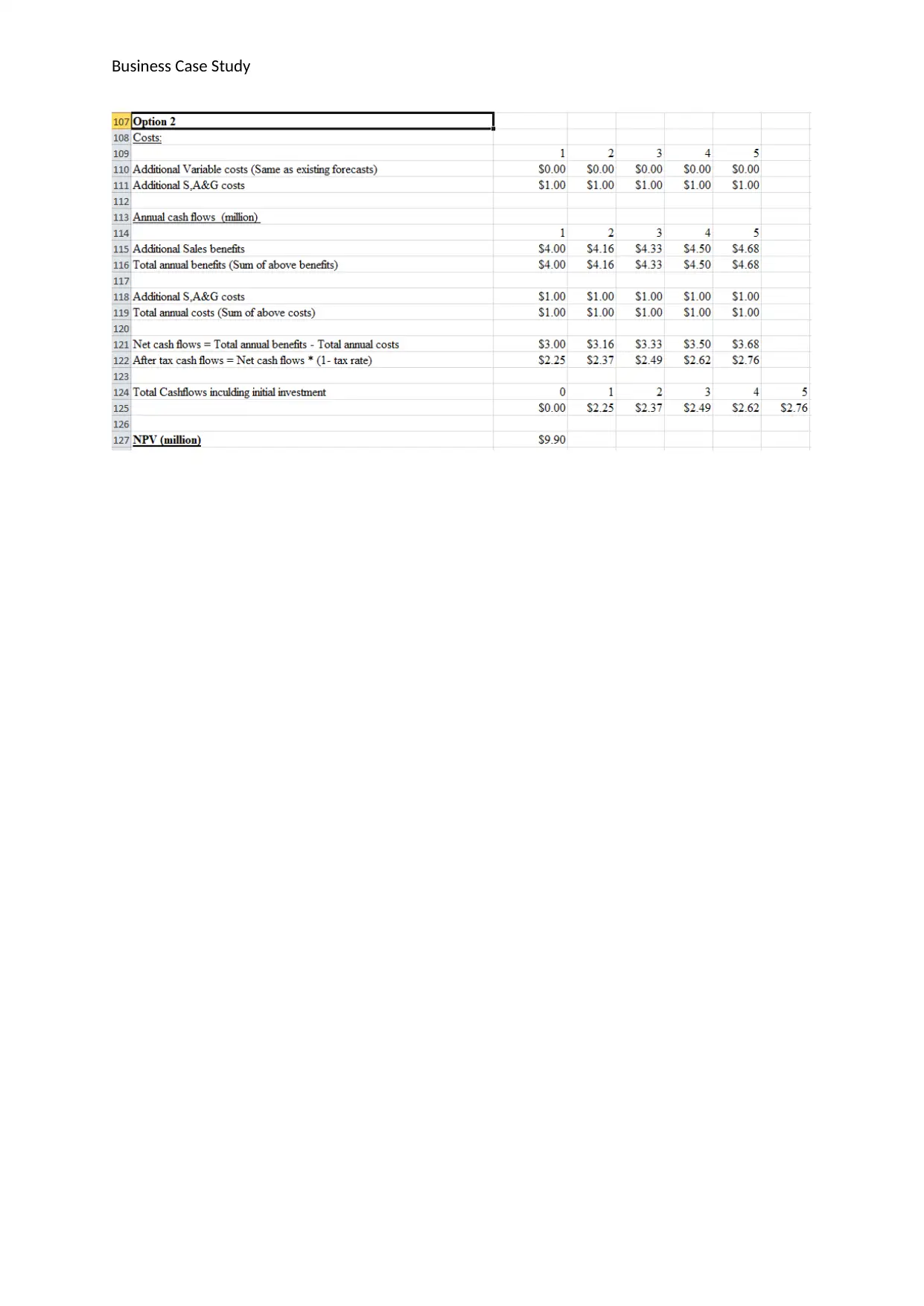
Business Case Study
Paraphrase This Document
Need a fresh take? Get an instant paraphrase of this document with our AI Paraphraser
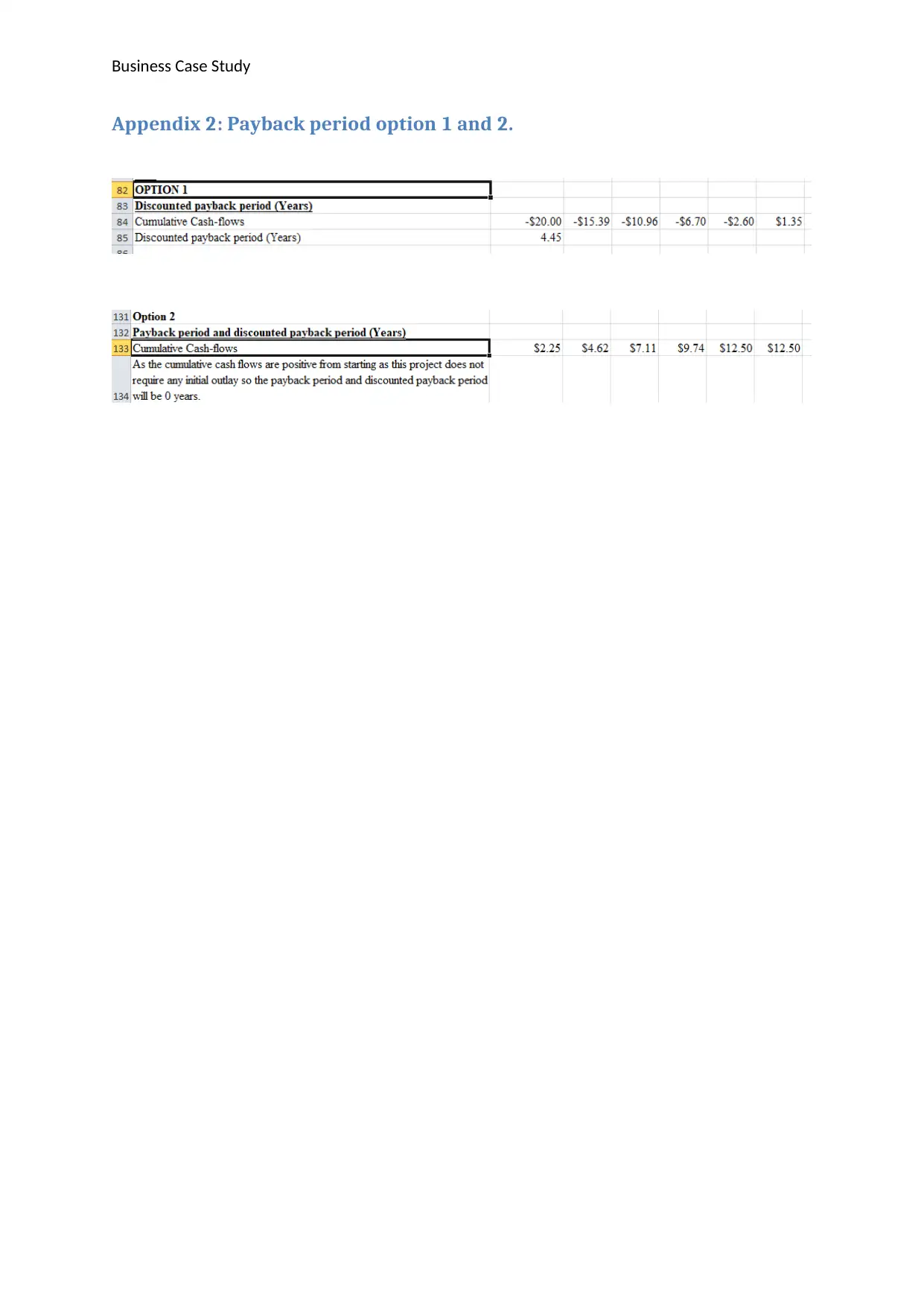
Business Case Study
Appendix 2: Payback period option 1 and 2.
Appendix 2: Payback period option 1 and 2.
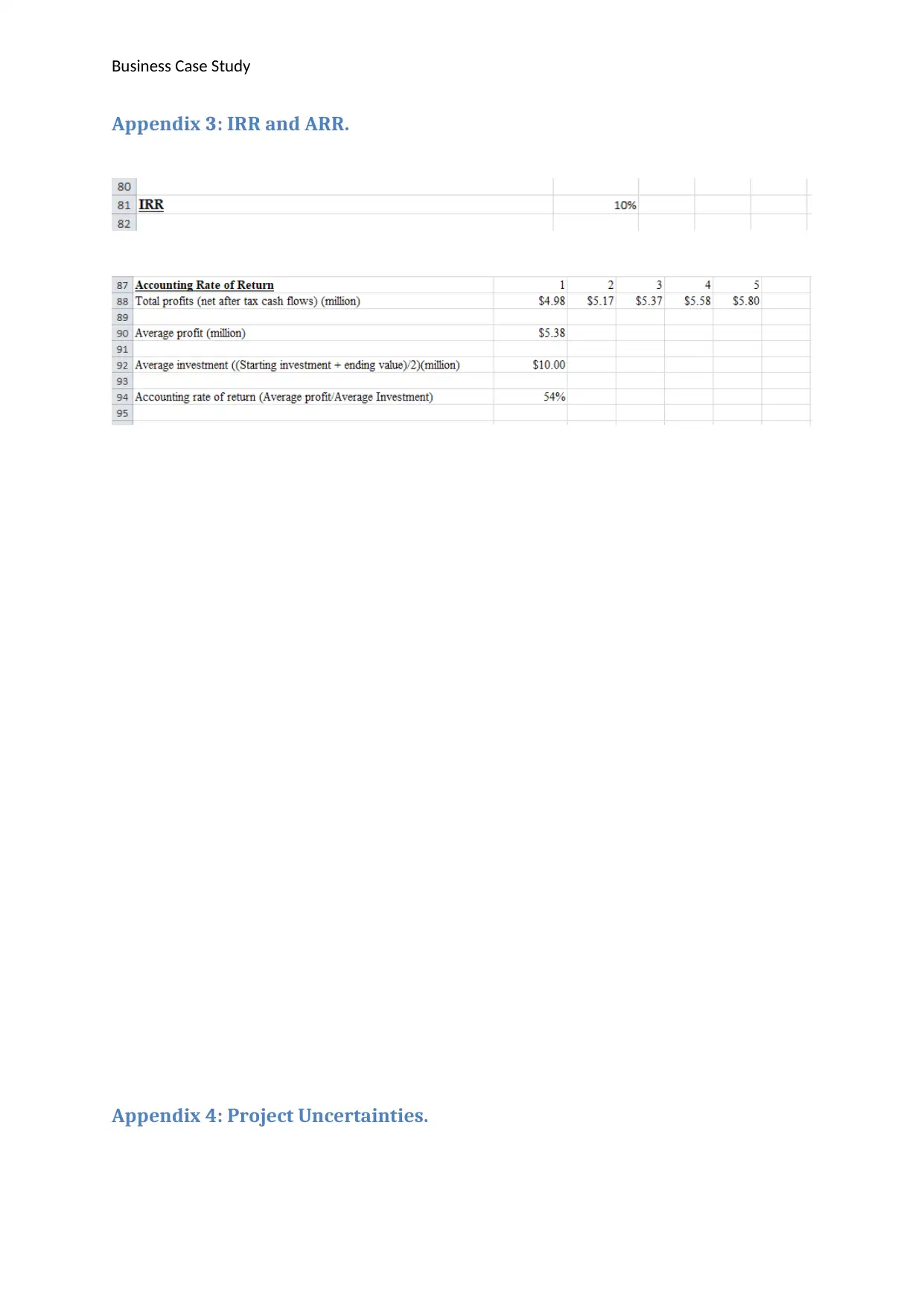
Business Case Study
Appendix 3: IRR and ARR.
Appendix 4: Project Uncertainties.
Appendix 3: IRR and ARR.
Appendix 4: Project Uncertainties.
⊘ This is a preview!⊘
Do you want full access?
Subscribe today to unlock all pages.

Trusted by 1+ million students worldwide
1 out of 13
Related Documents
Your All-in-One AI-Powered Toolkit for Academic Success.
+13062052269
info@desklib.com
Available 24*7 on WhatsApp / Email
![[object Object]](/_next/static/media/star-bottom.7253800d.svg)
Unlock your academic potential
Copyright © 2020–2025 A2Z Services. All Rights Reserved. Developed and managed by ZUCOL.





